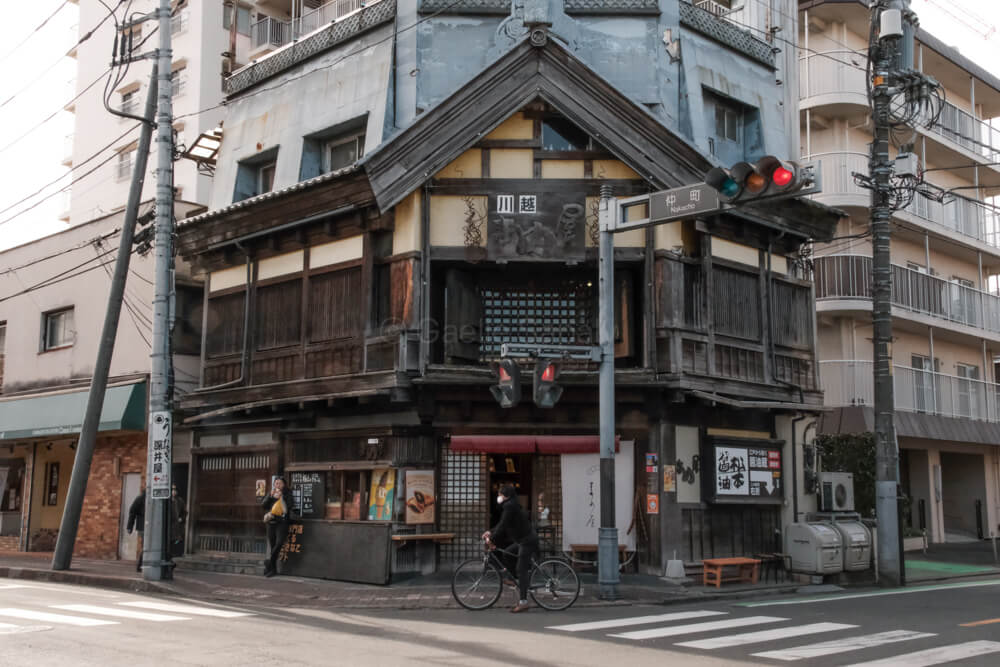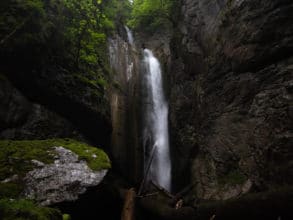Just 30 minutes by train from Tokyo, Kawagoe (川越) is a charming town perfect for a day trip from Tokyo. Nicknamed “Little Edo” for its atmosphere reminiscent of the Edo period (1603-1867), Kawagoe is rich in history. This article will guide you through the must-see attractions of this perfect day trip destination.
Little Edo: a day in feudal Japan
Kawagoe is famous for its preservation of Edo-period architecture. The main street, Kurazukuri no Machinami, is lined with traditional clay-walled buildings. Today, these buildings house shops, cafés, and restaurants, offering visitors an immersive experience of old Japan. While I usually avoid the word “immersive” because it’s overused for almost everything (even websites!), I think it is very appropriate in this context.


Kurazukuri no Machinami: The warehouse district
In the past, Kawagoe was an important commercial city that supplied resources to Edo (now Tokyo). Due to the thriving trade, many merchants became wealthy enough to build warehouses and shops. Japanese cities were almost exclusively made up of wooden buildings, which made them vulnerable to fires. This is why the Kurazukuri construction style was used.



The bell tower, Toki no Kane
The Toki no Kane Bell Tower (時の鐘) is the symbol of Kawagoe. Its name means “Time Bell,” and it chimes four times a day (at 6 am., noon, 3 pm., and 6 pm.). Although it dates back more than 400 years, the tower was reconstructed in 1894, after the Kawagoe fire in 1893.

Starbucks Kawagoe Kanetsuki-dori
The Starbucks in Kawagoe blends perfectly into the city’s traditional landscape. The building is designed in the traditional warehouse style and is located next to the Toki no Kane bell tower. I recommend the terrace at the back, which offers a lovely view of the Japanese garden.


Although I’m not particularly a fan of Starbucks, the Starbucks locations in Japan are more creative. For example, the Starbucks Reserve Roastery in Tokyo Meguro and the famous building designed by Kengo Kuma in Fukuoka.
Kashiya Yokochō street
Known as “Candy Alley,” Kashiya Yokocho is a street lined with shops selling traditional Japanese sweets.
An exploration of hidden streets
Wandering through the adjacent streets, away from the main road and tourist sites, I took advantage of having no other plans for the day to leisurely explore the other streets. These streets, blending the modern and the old, were deserted, with impressive electric wires overhead.



Kawagoe manhole covers
Manhole covers in Japan are famous for their unique artistic designs, and those in Kawagoe are no exception. Here, you can see representations of the famous Toki no Kane bell tower and the kurazukuri (old warehouses). Just like in Kawagoe, Tokyo’s manhole covers are also inspired by different neighborhoods and their iconic symbols. Next time you are in Tokyo, take a look. They are generally less colorful but just as beautiful.

Restaurants
Kotobukian Kuranomachi (寿庵蔵のまち店)
Do you like soba noodles? Kotobukian KuranoMachi is located in the historic Kurazukuri district (Ichiban-gai shopping street) in the center of Koedo Kawagoe. This restaurant serves Kawagoe’s specialty matcha soba. Soba noodles are one of the most popular Japanese dishes. Their flavor is unique, and they are healthy. Sobayu is the hot water in which the soba noodles, made from buckwheat and boiled before being served, have been cooked. When soba is cooked, nutrients dissolve into the water. Drinking a glass of sobayu is beneficial for digestion and is also recommended to help counteract the effects of alcohol.
The menu and opening hours are available on their website.

Yamaya (山屋)
Yamaya Kawagoe is an izakaya (Japanese-style pub) and a ryotei (high-end traditional restaurant) that has been serving seasonal Japanese cuisine since 1868 (the first year of the Meiji era). It offers a beautiful view of a Japanese garden and is located a 10-minute walk from Hon-Kawagoe Station. You can get a discount by presenting the SEIBU One Day Pass (1000¥), which is also valid for train journeys from Tokyo to Kawagoe.

Kitain temple (川越城)
Kitain Temple is a historic site built in the early 9th century. It houses remnants of Edo Castle and features 540 statues of Buddha’s disciples. Kawagoe Castle is the closest castle to Tokyo that is still accessible to visitors (Edo Castle is now the Imperial Palace, which is largely closed to the public).
Kawagoe Hikawa (氷川神社): a shrine for relationships
This nearly 1500-year-old shrine is known for granting wishes related to matters of the heart. It offers many charms, the most popular being a red pencil, symbolizing the red thread of fate. Since I had a recent mishap in my love life, I found it both amusing and appropriate. Located just a short distance from Tokyo, this shrine attracts many visitors from the capital seeking answers.


The red thread of fate
The Hikawa Shrine in Kawagoe sells a red-colored pencil called “akai enpitsu.” This “red pencil” is a special charm unique to the Hikawa Shrine. It symbolizes the red thread of fate that is believed to connect you to your destined person. The more you use the pencil (and consequently, the shorter it becomes), the closer you become to your destined person.
Ema tunnel
Don’t miss walking through the Ema tunnel. Ema are small wooden prayer plaques found in Japanese temples and shrines. Visitors write their wishes, prayers, or hopes for success on them and hang them on specially designated stands.


Omikuji
There are also wooden boxes with omikuji in the shape of goldfish. These randomly drawn fortunes provide advice and predictions on various aspects of life, ranging from great luck to great misfortune. Good predictions are kept as lucky charms, while bad predictions are tied to a tree in the shrine to ward off bad luck.


Kawagoe: victim of its own success
Kawagoe has become particularly touristy, especially on weekends due to its proximity to Tokyo. Although most visitors gather in a few historic streets, it immediately feels crowded. The automobile traffic is also heavy because the city is not entirely pedestrian-friendly, which detracts from the historical atmosphere. I’ve been fortunate to visit Kawagoe several times when it wasn’t too crowded.

Well-known to Tokyo residents, it is now also popular among foreign tourists. I hope this won’t deter you from visiting, as it is a perfect excursion from Tokyo.
Conclusion
Kawagoe is an ideal destination for those who wish to immerse themselves in Japan’s feudal past. Enjoy your day trip to Kawagoe and be charmed by “Little Edo” with its picturesque streets, ancient temples, and delightful restaurants and cafés.
Explore Little Edo of Sawara and the historic village of Boso no Mura from Tokyo
Just like Kawagoe, other day trips from Tokyo offer a journey back to Japan’s feudal past. Explore destinations such as Sawara, often called Little Edo, and the historic village of Boso no Mura. These excursions provide a glimpse into traditional Japanese architecture, serene landscapes, and rich cultural heritage, making them perfect for history enthusiasts and those looking to experience the charm of old Japan.
Sawara
Continue your journey through time with a visit to Sawara, also known as “Little Edo.” Located in Chiba Prefecture, Sawara is renowned for its canals and well-preserved traditional buildings, offering an authentic Edo period atmosphere. For more information, check out the dedicated article on Sawara.

Boso no Mura
Boso no Mura is an open-air museum featuring faithful replicas of houses and craft workshops. Unlike Kawagoe, it is a completely reconstructed village. Located near Tokyo, it offers visitors an immersive experience of traditional rural life in Japan. For more information, check out the dedicated article on Boso no Mura.

Getting to Kawagoe from Tokyo
Kawagoe is connected to central Tokyo by three railway companies: Tobu, Seibu, and JR. Kawagoe has three stations:
- Hon-Kawagoe Station (Seibu): This station is the closest to the main attractions.
- Kawagoe Station (JR and Tobu)
- Kawagoe-shi Station (Tobu)
The warehouse district, Kurazukuri no Machinami, is a 10-15 minute walk from Hon-Kawagoe Station.

Ligne Tobu: the easiest
- Departure Station: Ikebukuro Station
- Arrival Stations: Kawagoe Station (JR and Tobu), Kawagoe-shi Station (Tobu)
- Travel Time: 30 minutes
- Fare: 490¥
To reach Kawagoe Station and Kawagoe-shi Station, take the Tobu Tojo Line from Tokyo Ikebukuro Station.
Kawagoe Discount Pass
You can also purchase the “Kawagoe Discount Pass,” available only for foreign tourists, which offers a round trip between Tokyo Ikebukuro and Kawagoe for 710¥. It is valid for one day and can be bought at Ikebukuro Station. The pass also provides discounts at various locations in Kawagoe.
Ligne Seibu
Trains depart from Seibu Shinjuku to Kawagoe Station. There are frequent trains on the Seibu Shinjuku Line. Additionally, there are “Limited Express” trains that take about 45 minutes and cost 1120¥.
- Departure Station: Seibu Shinjuku Station
- Arrival Station: Kawagoe Station (Seibu)
- Travel Time: 50 minutes
- Fare: 520¥
For a quicker option, you can take the “Limited Express” trains:
- Travel Time: 45 minutes
- Fare: 1120¥
Ligne JR
Tokyo Shinjuku Station is connected to Kawagoe Station by frequent direct trains on the JR Saikyo/Kawagoe Line.
- Departure Station: Shinjuku Station (Tokyo)
- Arrival Station: Kawagoe Station (JR)
- Travel Time: 55 minutes
- Fare: 770¥
Japan Rail Pass
For those with the Japan Rail Pass, the journey is fully covered.
Getting around Kawagoe
Although the tourist sites are close to each other, it’s possible to take the bus to reach them. There are buses connecting the Kawagoe stations to the main sites of the city.
The Co-Edo Loop Bus: a one-day pass costs 500¥. It runs twice an hour with 2 routes.
The Tobu Koedo Loop Bus: a one-day pass costs 400¥. It runs every hour on weekdays and every 30 minutes on weekends.




